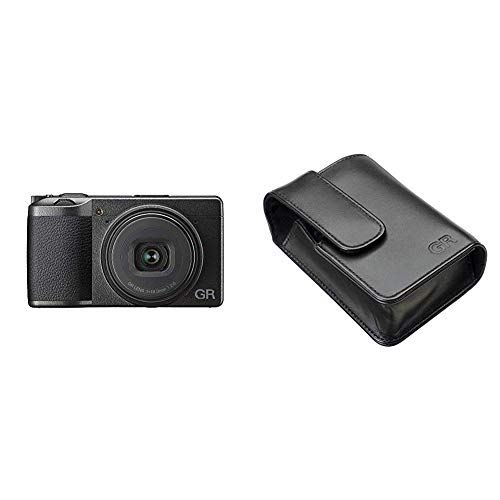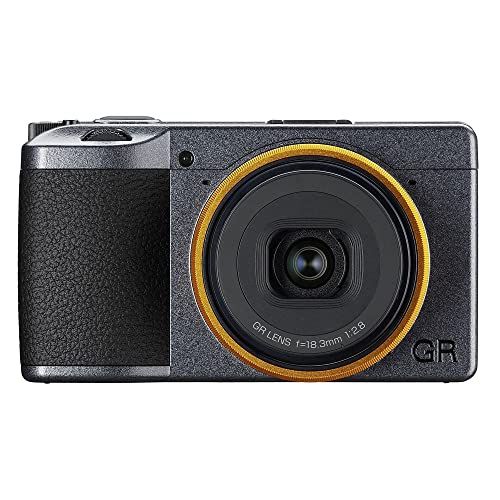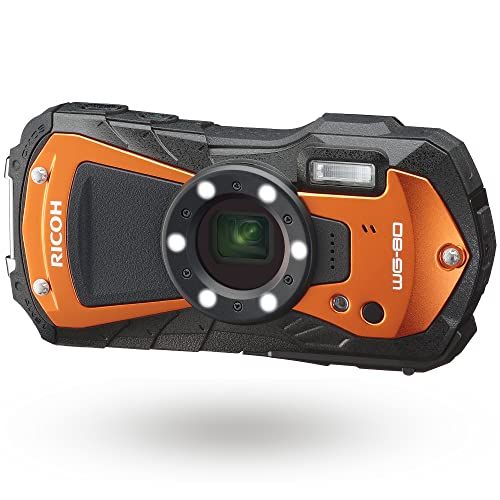Categories

Ricoh is a well-established Japanese brand known for its high-quality imaging products and innovative technology. Founded in 1936, the company has a long history of developing cameras, copiers, printers and other office equipment.
In the camera world, Ricoh is best known for its premium compact cameras and DSLRs. While not as mainstream as Canon or Nikon, Ricoh has earned a reputation among photography enthusiasts for its unique features, robust build quality and outstanding image quality.
Ricoh's cameras consistently deliver excellent image quality by utilizing large sensors and high-quality lenses. Many models have APS-C sized sensors, the same size found in entry-level DSLRs. This gives Ricoh compacts the edge over rivals in terms of low light performance, dynamic range and background blur.
At the same time, Ricoh cameras are packed with innovative features not found elsewhere. For example, some models have hybrid autofocus systems, 360 degree rotating LCD screens and even satellite positioning for geo-tagging photos. This focus on innovation ensures Ricoh stays ahead of the competition.
When it comes to build quality, Ricoh cameras are in a league of their own. They feature full metal bodies with extensive weather sealing to withstand dust, moisture and shocks. Controls and dials have a sturdy, premium feel. This robustness inspires confidence for using Ricoh cameras anywhere.
While Ricoh may not have the brand recognition of the major players, its cameras appeal to discerning photographers who value advanced technology, superior image quality and reliability. Let's take a closer look at what Ricoh cameras have to offer.
Ricoh Camera Lineup
Ricoh offers several different camera lines to meet the needs of various photographers. Here are some of their current models:
GR Digital Series - These advanced compact cameras are geared toward street photographers and photo enthusiasts. Models include the GR III, GR IIIx, and GR Digital IV. They have large APS-C sensors, prime lenses, full manual controls, and retro styling.
Theta Series - Ricoh's Theta lineup consists of 360-degree cameras for shooting immersive photos and videos. Current models include the Theta Z1, Theta V, and Theta SC2. They can capture 360° x 180° panoramic images in one shot.
WG Series - The rugged, waterproof WG cameras are built for adventure. They can withstand drops, shock, dust, crushing pressures and submersion in water. Current models are the WG-6 and WG-60.
GXR Interchangeable Unit Camera System - The GXR is a mirrorless camera that uses interchangeable lens units with APS-C sensors. Photographers can mount various lens/sensor units to the GXR body.
K Series - Ricoh's entry-level DSLR cameras have traditional DSLR styling and a range of features for beginner to intermediate photographers. Current models include the K-70, K-3 Mark III, and K-S2.
Ricoh caters to photographers who want robust prime lens cameras, 360-degree imaging, rugged cameras, and entry-level DSLRs. They continue to innovate with unique cameras like the modular GXR.
Features
Ricoh cameras are known for their excellent combination of imaging capabilities, performance, and build quality. Here are some of the standout features found across Ricoh's camera lineup:
Image Sensors - Ricoh uses high-quality APS-C sized image sensors in most of its DSLR and mirrorless cameras. These are larger than the sensors found in many competitor's cameras and allow for improved low light performance and dynamic range. Many Ricoh cameras have resolutions of 24MP or higher.
ISO Range - Wide ISO ranges up to 51200 are common in Ricoh cameras, enabling shooting in very low light scenarios. Image noise is controlled well through the range thanks to the high performing sensors.
Autofocus - Ricoh uses both contrast and phase detect autofocus systems across its cameras, with cross-type AF points for accuracy. Many models have over 100 AF points for wide coverage. AF modes like face detection and subject tracking enable getting sharp shots of moving subjects.
Image Stabilization - In-body 5-axis image stabilization is available on some Ricoh mirrorless models. This counteracts camera shake for sharper handheld shots and videos. Some lenses also have optical stabilization.
Shutter Speeds - Mechanical and electronic shutter options allow shutter speeds up to 1/8000s to freeze fast action or for creative effects.
Weather Sealing - Higher-end Ricoh DSLRs feature extensive weather sealing for use in dusty, wet, or cold conditions. This allows capturing images in challenging environments.
Ricoh packs its cameras full of capabilities to enable capturing incredible photos and videos in a wide variety of scenarios. The combination of proven imaging technology and reliability make them a great choice for enthusiasts and professionals.
Image Quality
Ricoh cameras are well known for their excellent image quality, delivering sharp, detailed images with accurate colors and impressive dynamic range. Compared to competitors, Ricoh cameras consistently perform near the top in independent testing for resolution, sharpness, noise control, and color accuracy.
The latest Ricoh models utilize advanced sensors and image processing engines to maximize image quality. They capture a high level of detail while keeping noise to a minimum even at high ISO settings. The results are crisp images with beautiful color rendition and wide dynamic range to handle challenging high contrast scenes.
Ricoh's renowned lenses also contribute to the stellar image quality. They produce sharp images from corner to corner with minimal distortion. The anti-aliasing filters are precisely tuned to balance resolution and moire control. Overall, Ricoh delivers professional-level image quality in a compact form factor.
The images have an appealing quality straight out of camera and require minimal post-processing. Photographers who value outstanding technical image quality will find a lot to like about Ricoh's offerings. The combination of advanced sensor technology, high-performance image processing, and precision optics enables Ricoh cameras to deliver some of the best image quality in their class.
Ergonomics
Ricoh cameras are known for their excellent ergonomic design that makes them comfortable and intuitive to use. The cameras strike a good balance between being compact yet still having ample grip for stable holding.
The button layout follows a logical design that allows quick access to the most important shooting functions. There are plenty of external controls while still leaving room for the rear LCD screen. The menus are clear and easy to navigate. Many settings can be customized to suit individual shooting preferences.
For example, the popular Ricoh GR III has a slim, pocketable body yet still feels secure in hand. The textured grip helps prevent slipping while the indented thumb rest on the back aids holding stability. It only weighs 257g including the battery and memory card. The control dials, function button, ADJ lever, and other external controls fall readily under the fingers. Despite its small size, it does not feel cramped or awkward to handle.
Overall, Ricoh cameras excel in their ergonomic design. This makes them a pleasure to shoot with over extended periods. Their slim bodies do not sacrifice handling comfort and their intuitive controls speed up operation. This is part of what makes Ricoh cameras popular choices among serious photographers who value usability.
Video Capabilities
Ricoh cameras offer impressive video capabilities that make them suitable for both amateur and professional videography. The latest Ricoh models can record high-resolution 4K video at up to 30 frames per second. Many models also offer Full HD 1080p video at frame rates up to 60fps for smooth, high-quality footage.
For video codecs, Ricoh cameras typically use H.264 compression, which provides a good balance of quality and file size. Some higher-end models offer more advanced codecs like HEVC for greater efficiency.
Autofocus in video mode is fast and accurate thanks to Ricoh's hybrid AF system that combines phase and contrast detection. This allows the cameras to quickly lock focus on the subject and track movement smoothly across the frame. Face detection and subject tracking are also available in video mode for keeping people or objects in focus automatically.
Overall, Ricoh delivers excellent video capabilities on par with competitors in the mirrorless and DSLR camera markets. The high-resolution options, frame rate flexibility, advanced codecs, and reliable autofocus make their cameras a great choice for multimedia creators.
Connectivity
Ricoh cameras offer excellent connectivity options to make transferring photos and accessing camera controls simple.
WiFi - Ricoh cameras have built-in WiFi that allows you to wirelessly transfer photos to your smartphone or tablet. Simply download the Ricoh app and you can quickly share photos from your camera to your mobile device.
Bluetooth - In addition to WiFi, Ricoh cameras include Bluetooth connectivity. This allows you to pair your camera with your smartphone to enable remote control and image transfer capabilities. Bluetooth provides a convenient always-on connection.
Mobile App - Ricoh offers full-featured mobile apps for iOS and Android that take advantage of the camera's wireless connectivity. You can remotely control the camera, view and transfer images, add GPS data to photos, and more. The app provides a great way to expand the functionality of your Ricoh camera.
Overall, Ricoh cameras provide excellent wireless connectivity options with WiFi, Bluetooth and mobile app integration. This makes it simple to wirelessly transfer your photos and control the camera remotely using your smartphone or tablet.
Special Features
Ricoh cameras are known for their unique capabilities that go beyond standard DSLR or mirrorless features. Here are some of the specialty functions that make Ricoh stand out:
Multi-Shot Modes - Ricoh offers multiple exposure, HDR, and pixel shift modes to capture images in new creative ways. The Multi-Shot SR mode takes a rapid burst of images and combines them to reduce noise and increase resolution and dynamic range. Pixel shift composites sequential shots with sensor movements between each to capture full color data at every pixel location.
Specialty Lenses - Ricoh has developed specialized lenses like the Ricoh Theta for 360 degree imaging. The Theta line captures fully spherical panoramas in a single shot. Ricoh also offers niche lenses like ultra-wide angle and fisheye designs. Macro lenses allow for extreme close-up photography.
In-Camera Editing - Ricoh cameras allow you to edit images and video within the camera itself. You can apply filters, adjust parameters like white balance and noise reduction, and edit files non-destructively.
Customization - Extensive custom function menus let you tailor Ricoh cameras to your shooting style. You can customize button layouts, dial functions, display options, and more.
Rugged Build - Ricoh DSLRs feature weather sealing and robust magnesium alloy bodies to withstand tough shooting conditions. This durability makes them a great choice for outdoor, travel, and demanding shoots.
Ricoh packs innovative capabilities into its cameras aimed at photographers seeking to push creative boundaries and capture incredible images. The specialty features let you shoot in ways other cameras simply can't match.
Accessories
Ricoh cameras have a wide range of compatible accessories to expand the system's capabilities. Here are some of the most popular accessory types for Ricoh cameras:
Lenses
Ricoh cameras use the Pentax K lens mount. This gives access to a huge selection of K-mount compatible lenses, including lenses made by Pentax, Ricoh, and third parties like Sigma and Tamron. Popular lenses include wide angle, telephoto, macro, and portrait primes. Zoom lenses like 18-55mm and 50-200mm are also very versatile.
Flashes
Ricoh has its own flashes like the AF540FGZ II and AF360FGZ II with features like wireless TTL. There are also many third party flash options from brands like Metz, Nissin, and Godox. Flashes add lighting versatility for portraits, macro shots, fill flash, and more.
Batteries
Ricoh cameras use D-LI90 lithium-ion rechargeable batteries. Battery grips can hold 2 batteries for extended shooting. There are also higher capacity battery options from third parties. Having spare batteries is recommended for all-day shooting.
Grips
Battery grips like the D-BG8 attach to the bottom and allow holding the camera vertically more comfortably. They also extend battery life. Other grips include the GC-9 for carrying/mounting flexibility.
Remote Controls
Cable releases allow triggering the shutter without touching the camera, helpful for long exposures and macro work. Infrared remotes like the RR-90 can wirelessly trigger from afar. These help get sharp shots by avoiding camera shake.
Conclusion
Ricoh cameras have a lot to offer serious photographers. They provide excellent image quality, intuitive controls, robust build quality, and innovative features not found in other brands. Some key strengths of Ricoh cameras include:
Excellent image quality - Ricoh uses high-quality APS-C sensors and advanced image processing engines to produce sharp, clean images with accurate colors. The lack of an anti-aliasing filter maximizes detail capture.
Intuitive controls - Ricoh cameras feature an array of dials, buttons, and customization options for quick access to shooting parameters. The user interface is designed for efficiency.
Robust build quality - Magnesium alloy bodies, weather sealing, and protective construction make Ricoh cameras suitable for demanding conditions.
Innovative features - Unique capabilities like sensor shift stabilization, hybrid AF, snap focus, and multi-shot modes expand creative possibilities.
Potential weaknesses to consider are more limited lens selection compared to major brands, less name recognition, and fewer models released annually. However, Ricoh rewards photographers who value outstanding image quality, refined handling, reliability, and innovation over flashy marketing. For many, the strengths make Ricoh cameras worth a close look.
Ricoh Cameras comparison
 |  |  |  |  | |
|---|---|---|---|---|---|
| Model | Ricoh GR III with GC-9 Soft Case | Ricoh GR IIIx Urban Edition | Ricoh GR III | Ricoh 28-300 f3.5-5.5 VC P10 | Ricoh WG-60 |
| Brand | Ricoh | Ricoh | Ricoh | Ricoh | Ricoh |
| Model Number | - | GRIIIx | Ricoh GR III | 28-300 | 03825 |
| Camera Lens | - | 40 mm | 28 mm | 300 mm | - |
| Colour | - | Black | Black | Black | - |
| Continuous Shooting Speed | - | 30 fps | 60 fps | - | - |
| Effective Still Resolution | 24 MP | 24 | 24.24 MP | 10 MP | 16 MP |
| Focus Type | - | - | - | Auto Focus | - |
| Has Image Stabilisation | - | Yes | Yes | Yes | - |
| Included Components | - | Ricoh GRIIIx Camera Body, Ricoh GC-11 Case | Camera Body Only | - | - |
| Item Weight | - | 640 Grams | 9.07 Ounces | 308 g | - |
| Max Focal Length | - | - | 18.3 | 300 Millimetres | - |
| Maximum Shutter Speed | - | - | 30 seconds | - | - |
| Memory Slots Available | - | 1 | 1 | - | - |
| Min Focal Length | - | - | 18.3 | 28 Millimetres | - |
| Minimum Shutter Speed | - | - | 30 seconds | - | - |
| Model Year | - | 2022 | 2019 | - | - |
| Style | - | Standard Camera | Standard Camera | Unité P10 28-300 mm | - |
| Zoom Type | - | Optical Zoom | Digital | Optical Zoom | - |
| Photo Sensor Size | APS-C | APS-C | APS-C | - | Compact |
| Model Name | GR III | Ricoh GRIIIx Urban Edition | Ricoh GR III | vc p10 | WG-60 |
FAQ
What is Ricoh?
Ricoh is a Japanese imaging and electronics company. They are known for making office equipment such as printers, photocopiers, fax machines and cameras. Ricoh was founded in 1936 and is headquartered in Tokyo, Japan.
What types of cameras does Ricoh make?
Ricoh makes a wide range of digital cameras including point and shoot, mirrorless interchangeable lens, and DSLR cameras. Some of their popular camera lines include the GR series, Theta 360 degree cameras, Pentax DSLRs, and the WG rugged cameras.
What are some key features of Ricoh cameras?
Some standout features of Ricoh cameras include:
Excellent image quality and low light performance
Compact and lightweight camera bodies
Intuitive controls and menu systems
Rugged, weatherproof construction on some models
Innovative features like 360 degree imaging
Does Ricoh manufacture its own camera sensors?
No, Ricoh does not manufacture its own image sensors. For its DSLR and mirrorless cameras it relies on sensors made by other companies like Sony and Toshiba. The image processing is done by Ricoh though.
Where are Ricoh cameras made?
While Ricoh has its headquarters in Japan, its cameras are manufactured in several different countries. DSLR and mirrorless cameras are typically made in Thailand and Indonesia. Point and shoot models are often made in China.
What is the price range of Ricoh cameras?
Ricoh cameras range in price from around £100 for basic point and shoot models up to over £1,500 for high-end DSLRs and lenses. Their mid-range mirrorless cameras cost around £400 to £800. The GR premium compact series costs around £700 to £900.
Does Ricoh make its own lenses?
Yes, under the Pentax brand, Ricoh designs and manufactures interchangeable lenses for its DSLR and mirrorless cameras. This includes a variety of prime, zoom, macro and specialty lenses.
How does Ricoh compare to other camera brands?
Ricoh is smaller than top brands like Canon, Nikon and Sony. But Ricoh/Pentax cameras are well-respected for very good image quality, durability, and value for money. They have a loyal niche following among photo enthusiasts.
Where are Ricoh cameras sold?
Ricoh cameras are sold worldwide at electronics and camera stores. Some of their major markets include Japan, North America, Europe, China, and Southeast Asia. Many Ricoh cameras are also sold online at major retailers like Amazon.
What is Ricoh's photography heritage?
Ricoh has a long history in photography stretching back to the 1930s. This includes companies like Pentax that Ricoh acquired. Today, Ricoh continues to innovate and produce high-quality cameras and lenses for enthusiasts and professionals.








